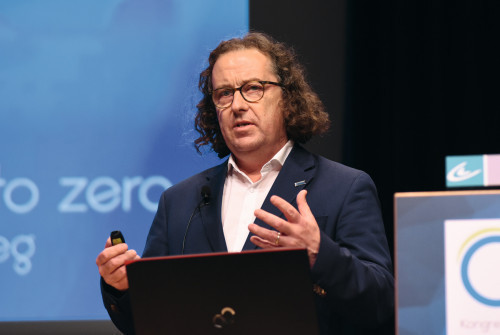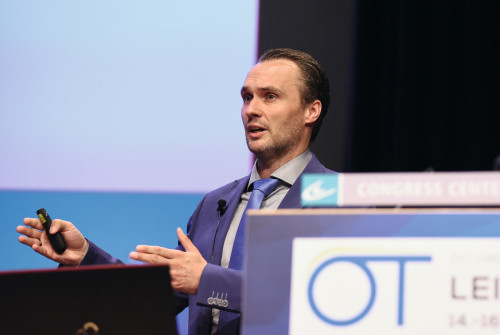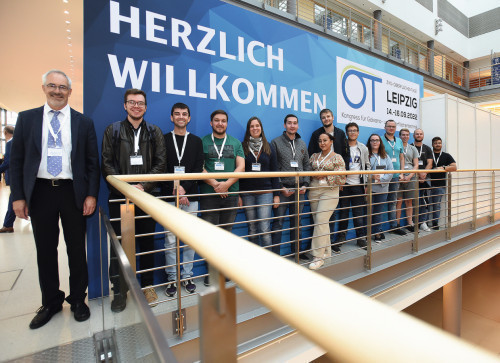The first day of the congress after the opening was September 15. The lecture program started in the Congress Center on the edge of the Leipzig exhibition grounds. Around 50 of the 90 lectures were held on this day. A large block dealt with climate neutrality & energy and resource efficiency (please also read our article "The path to a climate-neutral company" on p. 1457). The ZVO had initiated an energy forum to kick off the day specifically because of the energy problems resulting from the war in Ukraine.
Energy forum
The high price increases in energy procurement are threatening the existence of energy-intensive electroplating and coating companies. Anke Herzel and Silvia Bauer, bwh-energy GmbH, named the reasons for the high energy prices. The price increases already occurred in 2021, when there was an unusual wind lull in parts of Europe and the feed-in of wind energy was significantly lower. As a result, more coal had to be used again to generate electricity. Demand for EU emission allowances increased, which led to a further rise in electricity prices. In addition, Germany is supplying more electricity to France than ever before.
Anke Herzel presented options for purchasing energy and alternatives to the fixed price. On the one hand, there is the option of procuring energy via the futures market. Here, fixed prices can be planned over a fixed term. It is also possible to purchase in tranches at different times. However, hidden costs for risk premiums or margins must be expected and there is little flexibility in terms of consumption. On the other hand, energy can be procured via the spot market, which has the advantage that there are no hidden costs and the pure exchange price is paid. Many companies use both options, whereby it is recommended that 70% is purchased via the futures market and 30% via the spot market.
In recent weeks, the German government has adopted various packages of measures to ease the burden on energy-intensive companies, such as a KfW loan program, guarantee programs, energy cost reduction programs and support for energy companies in the event of certain liquidity bottlenecks. For example, the cost share of a doubling of energy costs compared to 2021 will be subsidized with grants of 30 to 70 %. However, the hurdle for this is that audited financial statements must be available, which can easily cost companies 12,000 euros. Other planned relief measures include the extension and adjustment of the energy cost reduction program for energy-intensive companies, an electricity price cap for small and medium-sized companies with a utility tariff and the extension of the peak equalization scheme for manufacturing companies for a further year. The speakers recommended identifying and implementing as many energy-saving measures as possible in companies in order to save costs. Grid charges can be reduced through atypical grid usage or targeted peak load smoothing with measurement and control technology. Energy audits can also help to reduce further energy levies and charges or exempt companies from them.
Discussion
In the lively discussion that followed, entrepreneurs reported on how they had converted heating systems for process solutions to propane gas, how they wanted to use oil heating again or how they wanted to operate heating systems with biogas but could not for legal reasons, as well as their fear that energy supply companies would go bankrupt. They all have to pass on the high energy prices to their customers, and initial experience has shown that customers react with understanding.
Lars Baumgürtel, ZINQ GmbH & Co. KG, reported on the visit to his company by Federal Minister of Economics Robert Habeck, during which the exorbitant energy prices were discussed. A letter from ZVO was handed over, appealing to Habeck to defuse this situation and, among other things, to abolish or at least temporarily suspend the merit order system. Baumgürtel calls for uniform electricity and gas prices for industry in Europe. Environmental standards in Germany are still better than in China. From a climate policy perspective, it is therefore better to support companies in Germany so that production can continue here.
The Energy Forum showed how explosive energy procurement is. Entire value chains are in danger of collapsing. This is why the ZVO is calling on electroplating companies to write to members of the Bundestag or even the Federal Minister of Economics with their own incendiary letters.
Climate neutrality and energy and resource efficiency
The corporate carbonfootprint(CCF) describes all of a company's climate-impacting emissions. Thecarbon footprint can be used to estimate how climate-friendly the company's operations are. Measures can also be defined for a climate protection plan.
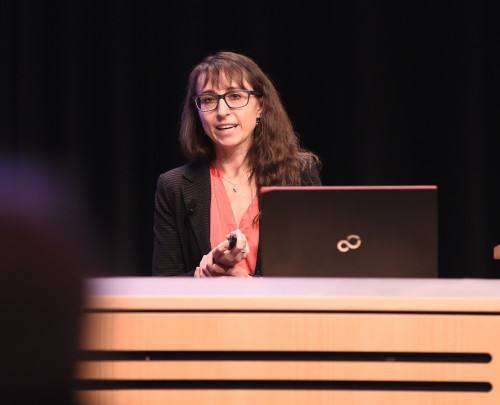 Anna-Theresa Schmidt from Dr.- Ing. Max Schlötter GmbH informed the audience about the contents of the carbon footprint
Anna-Theresa Schmidt from Dr.- Ing. Max Schlötter GmbH informed the audience about the contents of the carbon footprint
Anna-Theresa Schmidt, Dr.- Ing. Max Schlötter GmbH & Co. KG, explained how she calculated the emission sources in the company according to the Greenhouse Gas Protocol (GHG Protocol), divided into Scope 1, 2 and 3. Scope 1 includes all direct emissions, such as the vehicle fleet; Scope 2 is indirect emissions from purchased energy. It recommends evaluating the invoices for this. Scope 3 emissions are also indirect emissions that occur along the value chain, such as for the raw materials used, logistics, business travel and employee commuting. These are the largest item, accounting for around 70 percent of emissions. During the discussion, it became clear that no reliable data is yet available for raw materials. Therefore, the footprint cannot yet be specified for all of the company's products. However, suppliers to the automotive industry are dependent on this data.
Björn Dingwerth, MacDermid Enthone Industrial Solutions, reported on reduced emissions and the associated savings potential using the example of acidic and alkaline zinc-nickel processes. The respective pre- and post-treatments, such as cleaning, passivation and sealing with drying, must be taken into account. The savings potential for the heated processes is considerable, particularly due to the increased energy costs. This is why the use of adapted process solutions that work at lower temperatures is so efficient and results in significant savings potential.
In view of the rise in energy prices, Manfred Hofschneider, Tribicon GmbH Ingenieurgesellschaft für Unternehmensberatung, recommends reducing energy requirements through compressed air management (elimination of leaks, consumption-based control), optimization of switch-off and switch-on strategies, heat recovery or insulation. With knowledge of consumption, discontinuous processes can be optimally coordinated in order to avoid consumption peaks, for example. It goes without saying that unneeded lighting, heating or cooling systems are switched off. Costs can be reduced with strategic energy purchasing. BAFA or AGVO subsidies help to implement measures to reduce energy consumption and therefore costs.
"A circular economy has the potential to reduce greenhouse gas emissions by 39% and resource consumption by 28%. Nevertheless, only 9% of the global economy is circular," said Lars Baumgürtl, ZINQ Technologie GmbH, quoting the Circularity Report of 2022. On the one hand, the sustainability of products is promoted with footprint data on products, the Ecodesign Ordinance or the product passport. On the other hand, circular business models include closing material cycles and providing take-back guarantees, such as for hot-dip galvanized crash barriers. The future business models of the surface industry, including its supply chains and customers, must face up to these challenges.
Felix Heinzler, BIA Kunststoff- und Galvanotechnik GmbH & Co KG, spoke about the circular economy through the use of recycled materials for galvanized plastics. ABS plastics are available as virgin material with bio-based or recycled content. Plastics with recycled content must of course meet the quality requirements. Returning rejects from plastic electroplating to the material cycle is difficult and still in the test phase. A process combination of shredding to separate plastic and metal and reprocessing makes it possible to return both fractions to the material cycle. The metals are sent for external processing and the plastics are melted down again.
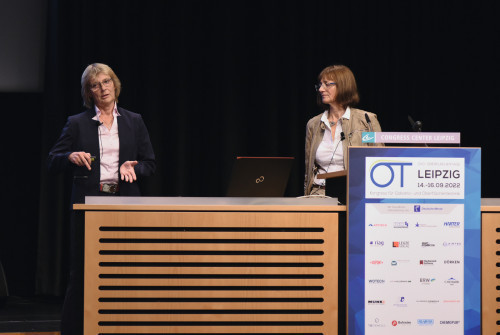 Elke Moosbach (right), Moosbach & Kanne GmbH, and Elke Spahn, Gravitech GmbH. They spoke about climate neutrality and sustainability as challenges for small and medium-sized companies
Elke Moosbach (right), Moosbach & Kanne GmbH, and Elke Spahn, Gravitech GmbH. They spoke about climate neutrality and sustainability as challenges for small and medium-sized companies
Climate neutrality and sustainability are immense challenges for small and medium-sized companies, as the experiences of Elke Moosbach, Moosbach & Kanne GmbH, and Elke Spahn, Gravitech GmbH, showed. To reduce theCO2 footprint, not only are the electroplating processes optimized, but façades are also insulated, PV and storage systems installed and air heat exchangers fitted. Digitalization plays a major role, as digitally recorded measured values are easier to evaluate and processes can be regularly checked and automated. This in turn means that fewer process chemicals can be used, so less waste water is produced, fewer waste water treatment chemicals are needed and theCO2 footprint is reduced. It will only be possible to create a product passport for theCO2 footprint of electroplated products when the supplier companies provide the data for the raw materials purchased, which is not yet the case.
The energy requirement for the rectifiers used in electroplating companies can be significantly reduced if energy-efficient rectifier systems are used. Lukas Büscher, Munk GmbH, presented funding programs which, in addition to the annual energy costs saved, also provide a one-off subsidy based on the kilowatt hours saved per year.
Michael Schem, MacDermid Enthone Industrial Solutions - Conventya GmbH, presented modern sealing and top coat systems, taking sustainability aspects into account. He recalled the Saxon mining chief Carlowitz as the creator of the term "sustainability", who said as early as 1713, in the face of a shortage of wood, that only as much wood should be felled as can grow back through planned reforestation. In his lecture, he presented various corrosion protection systems, which differ in terms of performance, but also in terms of the amount of raw materials and energy required. Although the topcoats are more efficient, many corrosion protection systems manage with an air-drying sealant. For this reason, the requirement profiles should be critically scrutinized and a decision made in favour of the sealer or the top coat system depending on this.
If zinc flake coatings are process-optimized, resources are saved and theCO2 footprint is reduced. The layer thickness of zinc flake coatings is significantly thinner than that of zinc dust coatings. The coatings also have higher electrical conductivity and therefore better cathodic corrosion protection. Tomislav Marić, Atotech GmbH & Co. KG, presented anhydrous and anhydrous zinc flake coatings. The curing temperature for the anhydrous systems is lower, which reduces energy costs. New additives have been developed with which the temperature can be further reduced. The speaker also called for corrosion protection requirements to be defined and the coatings to be adapted accordingly.
Functional coatings
By incorporating TiO2 nanoparticles into anodizing layers, photocatalytic properties for air purification can be generated, as Sigrid Benfer, Dechema Research Institute, reported. Facade materials should help to reduce the NOx content in the air. The TiO2 particles were introduced into the anodized layers by means of dip coating. The photocatalytic activity through NOx degradation on the modified layers was verified using the DeNOx test. If the facades are cleaned with commercially available products, they remain corrosion-resistant, which was demonstrated with resting potential and impedance measurements as well as current density-potential curves.
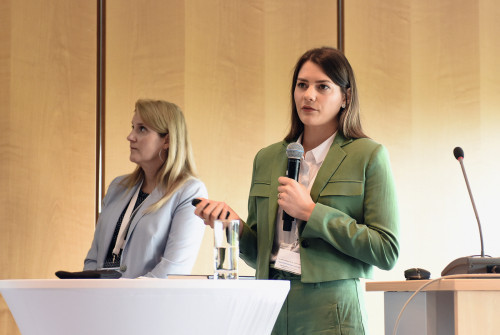 Are there alternatives to the fixed price? Anke Herzel and Silvia Bauer (in the background) from bwh-energy GmbH answered this question at the Energy Forum
Are there alternatives to the fixed price? Anke Herzel and Silvia Bauer (in the background) from bwh-energy GmbH answered this question at the Energy Forum
Christoph Kiesl, Research Institute for Precious Metals and Metal Chemistry, presented the contact and long-term behavior of self-lubricating coatings in current-carrying connections in electrical power engineering. The incorporation of selected dispersoids in silver coatings was successfully implemented for cyanide electrolytes. Controlled hydrodynamics are very important for homogeneous incorporation. The silver-graphite, silver-MoS2 and silver-WS2 coating systems exhibited good tribological behavior. The silver-hBN system, on the other hand, does not improve the tribological properties. The incorporation of the dispersoids slows down the decrease in hardness compared to pure silver coatings. The aging of the dispersion layers at 180 °C/2000 h showed that copper diffuses from the base material into the respective silver layer system, which is why barrier layers are important. Possible areas of application are outdoor or gas-insulated systems and cables in electrical energy technology as well as plug connections for charging plugs in the field of electromobility.
The whisker growth of electroplated tin layers is determined by the speed of tin grain recrystallization on the one hand and intermetallic phase formation on the other, as André Egli, riag Oberflächentechnik AG, emphasized. An efficient measure to suppress whisker growth is the deposition of a nickel layer before tinning.
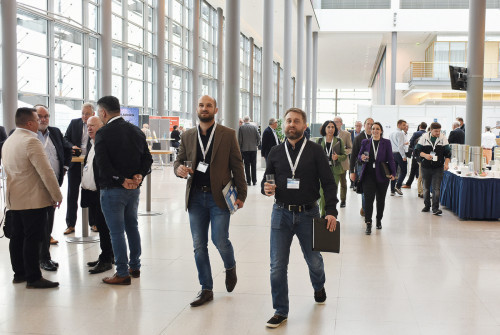 During the breaks, participants crowded into the aisles and visited the stands at the accompanying trade exhibition
During the breaks, participants crowded into the aisles and visited the stands at the accompanying trade exhibition
Heidi Willing, Research Institute for Precious Metals and Metal Chemistry, presented the process development for aluminum as a material for conductors and connectors in automotive electronics using adapted tin alloy layers. Aluminum alloys are lighter and cheaper than copper alloys, which is why they are to be used in automotive electronics. However, the surface treatment must be adapted for this. Aluminum pretreatment with zincate processes involves several process steps, which is time-consuming. In principle, tin alloy coatings can be applied to higher-alloyed aluminum materials to ensure adhesion.
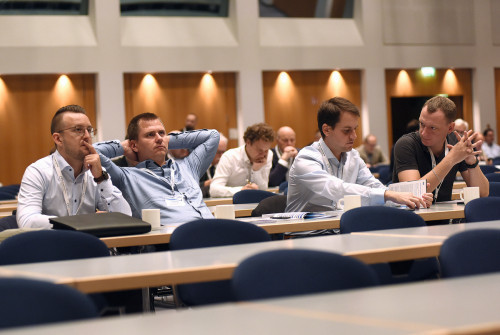 Audience at one of the presentations. The interest was great - as was the wealth of different topicsThesearch for alternatives to chromium(VI)-containing coatings from the perspective of a large automotive supplier was described by Martina Bubrin, Robert Bosch Manufacturing Solutions GmbH. Various solutions, such as galvanic NiW deposition or tungsten carbide in a metal matrix, applied by means of thermal spraying in the HVOF process, were examined as Cr(VI) alternatives. The alternatives of CrN and DLC with PVD as well as CrN and impact layer using PVD were also unable to replace conventional hard chrome plating in the area of diesel and gasoline injection systems. In the subsequent discussion, it was critically noted that hard chrome plating is still possible outside the EU and that production sites are therefore being relocated.
Audience at one of the presentations. The interest was great - as was the wealth of different topicsThesearch for alternatives to chromium(VI)-containing coatings from the perspective of a large automotive supplier was described by Martina Bubrin, Robert Bosch Manufacturing Solutions GmbH. Various solutions, such as galvanic NiW deposition or tungsten carbide in a metal matrix, applied by means of thermal spraying in the HVOF process, were examined as Cr(VI) alternatives. The alternatives of CrN and DLC with PVD as well as CrN and impact layer using PVD were also unable to replace conventional hard chrome plating in the area of diesel and gasoline injection systems. In the subsequent discussion, it was critically noted that hard chrome plating is still possible outside the EU and that production sites are therefore being relocated.
Fiber-reinforced plastics are often used in lightweight construction. By electroplating the fibers with thin layers of Fe-Co, the fibers are given permanent magnetic functionality, as Dominik Höhlich, TU Chemnitz, pointed out. An externally applied magnetic field gives the fibers a direct orientation. Entire fiber bundles are coated; the process parameters, such as added complexing agents and coating time, must be adjusted to the adhesive strength, crystallinity of the layers and scattering.
Julia Dukwen, Aalberts Surface Technologies GmbH, presented a chromium(VI)-free electrolyte for selective hard anodizing. Up to now, very smooth coatings have been obtained on high-silicon aluminum casting materials with chromium(VI)-containing electrolytes. With chromium(VI)-free electrolytes based on sulphuric acid with molybdenum and tin additives, customer requirements can generally be met and comparable coating properties achieved. To reduce the resulting roughness, which depends on the material used, the process parameters (temperature, voltage and flow rate) are adapted to the requirements.
AMC filters are used to keep the ambient air clean. To ensure that a breakthrough does not go unnoticed, cost-effective breakthrough detectors with electrochemically active surfaces are to be developed for the contaminants ammonia and formaldehyde, as Gloria Lanzinger, Research Institute for Precious Metals and Metal Chemistry, reported. The sensitivity of the sensor is to be maintained with conductive polymers. To increase the selectivity, metallic nanoparticles are applied to the polymers galvanically using pulse plating technology and incorporated into the polymer layer.
INFO
School group visits surface days
At the invitation of the ZVO, a delegation from Gewerbliche Schule Schwäbisch Gmünd also visited this year's Surface Days in Leipzig from September 14 to 16. The students from the technical college for electroplating technology in Schwäbisch Gmünd gained exciting insights into the industry, technologies and trends in the 90 or so presentations. On the fringes of the lecture program and in the industry exhibition, they had the opportunity to make contacts for their future careers. The vocational school for surface coaters at the Gewerbliche Schule Schwäbisch Gmünd is a dual partner for vocational training in industrial and craft businesses throughout Germany. At the vocational school for electroplating technology, further training (two-year full-time course) to become a state-certified technician specializing in electroplating technology or printed circuit board technology is possible after relevant vocational training.
Photos: Sven Hobbiesiefken


